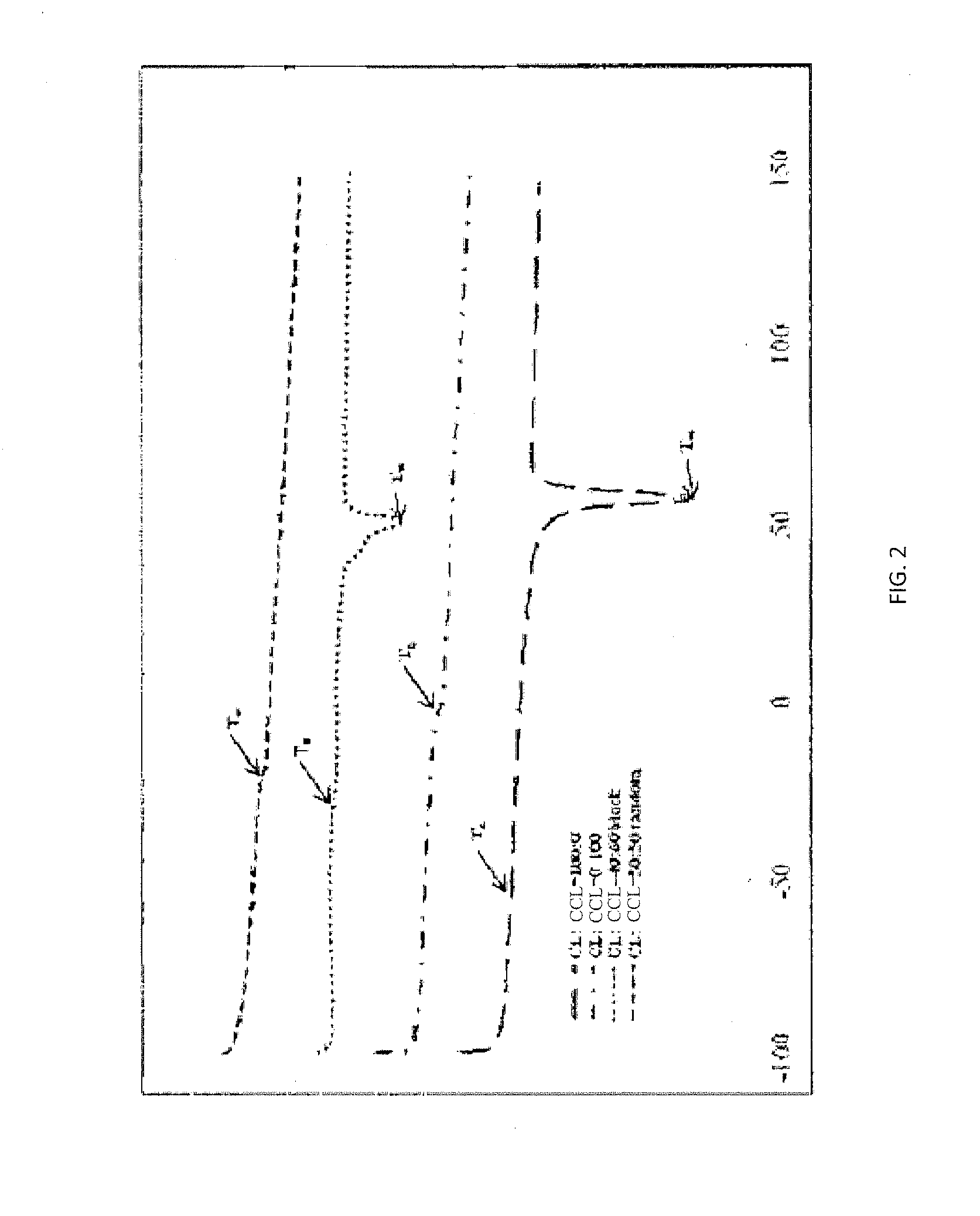Biodegradable shape memory polymer
a polymer and shape technology, applied in the field of biodegradable shape memory polymer, can solve the problems of limited recoverable deformation, lack of biodegradability, high manufacturing cost, etc., and achieve the effect of controlling the biodegradation rate of (co)polymers
- Summary
- Abstract
- Description
- Claims
- Application Information
AI Technical Summary
Benefits of technology
Problems solved by technology
Method used
Image
Examples
example 1
Functionalization of Caprolactone with a Cinnamoyl Moiety (CCL) and Synthesis of the Corresponding Copolymers Materials
[0085]Cinnamoyl chloride (Aldrich, 98%), 1,4-cyclohexanediol (Alfa Aesar, 98+%), Pyridinium chlorochromate (Alfa Aesar, 98%), Triethylamine (Alfa Aesar, 99%), 3-chloroperoxybenzoic acid (Alfa Aesar, 70-75%), ethyl acetate (Aldrich., ˜99.5%), triethylene glycol (Aldrich, 99.8%), Hydrochloric acid (Mallinckrodt chemicals, 36.5-38%) sodium chloride (Aldrich, ˜99.5%), methylene chloride (Aldrich, 99.5%), magnesium sulfate (Fluka analytical, 98%), Caprolactone (Alfa Aesar, 99%), Toluene (Aldrich., 99.9%), Tin(II) 2-ethylhexanoate (Sn(Oct)2. Aldrich, 95%), acetic acid (Aldrich, 99.7%), hexane (Aldrich, ˜99.8%), tetrahydrofuran, (THF, Aldrich., 99.9%). THF and toluene were distilled over sodium metal and benzophenone under nitrogen atmosphere. Methylene chloride was distilled before the reaction. All other chemicals were used as received.
1. Synthesis of 3-Phenyl-acrylic ac...
example 2
Synthesis of the Compound of Structural Formula (IX)
[0098]The compound of formula (IX)
was synthesized according to the following synthetic scheme:
[0099]ε-caprolactone was modified to obtain an aromatic or carboxylic group on the core-forming block as shown in Scheme (A). Anionic activation of ε-caprolactone monomer was performed using a freshly prepared non-nucleophilic strong base diisopropylamine (LDA) to extract a methylene proton from the α-position (—CH2-C═O). The generated lithium carbanion was then quenched with cinnamoyl chloride to obtain an α-cinnamoyl-ε-caprolactone derivative. After column chromatography the modified ε-caprolactone was isolated as a white solid. The yield of the reaction was about 30%. The structure was confirmed by a combined analysis of 1H NMR, 13C NMR, 2D-NMR
example 3
Post-Modification of Polymer
[0100]Bu—Li (24 mL) in hexane was slowly added to dry diisopropylamine (8.4 mL) in 60 mL of dry THF in a three-neck round-bottomed flask at −30° C. under vigorous stirring with continuous argon supply. The solution was cooled to −78° C. Poly(ε-Caprolactone) (3.42 g) was dissolved in 8 mL of dry THF and added to the above-mentioned mixture slowly, followed by the addition of Cinnamoyl chloride (5.1 g). The temperature was allowed to rise to 0° C., and the reaction was quenched with 5 mL of saturated ammonium chloride solution. The reaction mixture was diluted with water and extracted with dichloromethane. The combined extracts were dried over Na2SO4 and evaporated. The polymer is than dissolved in THF and precipitated with cold methanol.
[0101]The chemical structure can be analyzed by 1H NMR, 13C NMR, IR, and mass spectroscopy.
PUM
| Property | Measurement | Unit |
|---|---|---|
| transition temperature | aaaaa | aaaaa |
| glass transition temperature | aaaaa | aaaaa |
| melting point | aaaaa | aaaaa |
Abstract
Description
Claims
Application Information
 Login to View More
Login to View More - R&D
- Intellectual Property
- Life Sciences
- Materials
- Tech Scout
- Unparalleled Data Quality
- Higher Quality Content
- 60% Fewer Hallucinations
Browse by: Latest US Patents, China's latest patents, Technical Efficacy Thesaurus, Application Domain, Technology Topic, Popular Technical Reports.
© 2025 PatSnap. All rights reserved.Legal|Privacy policy|Modern Slavery Act Transparency Statement|Sitemap|About US| Contact US: help@patsnap.com



